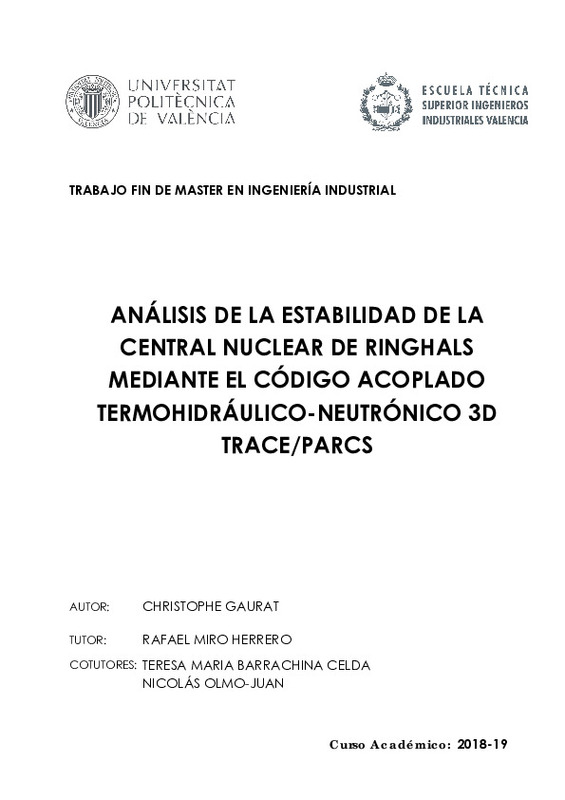|
[ES] Los reactores de agua a ebullición BWR están sujeto a oscilaciones de potencia en condiciones de operación determinadas, particularmente en situaciones de alta potencia y bajo caudal. Debido a la imposibilidad de ...[+]
[ES] Los reactores de agua a ebullición BWR están sujeto a oscilaciones de potencia en condiciones de operación determinadas, particularmente en situaciones de alta potencia y bajo caudal. Debido a la imposibilidad de estudiar dicho problema en la propia planta, se han desarrollado diversos códigos Best Estimate que permiten representar inestabilidades para posteriormente analizarlas y llegar a conocer en profundidad sus causas. El método de simulación utilizado en el presente trabajo es el acoplamiento de los códigos TRACE/PARCS. Para comprobar la validez de dicho método, se va a representar un evento de inestabilidad que tuvo lugar en la central nuclear de Ringhals.
Se realiza un análisis de estabilidad tridimensional en el dominio temporal sobre el reactor Ringhals 1, mediante el código acoplado TRACE/PARCS. Se analiza el caso conocido como BOC 14 Record 9 en el NEA Ringhals I BWR Stability Benchmark. Este punto de test fue clasificado como una oscilación fuera de fase y se encuentra en la región de inestabilidad del mapa de potencia-caudal.
Se quieren reproducir los resultados estacionarios y transitorios obtenidos en el benchmark, utilizando un modelo simple del núcleo y un modelo detallado de la vasija. Se configuran estos dos modelos para cumplir las condiciones de operación del benchmark. Se obtienen similitudes de caudales y perfiles de potencia que permiten otorgar validez los modelos realizados por TRACE y PARCS. A partir de este punto, se analizan transitorios sin y con perturbación. Las perturbaciones son cuatro movimientos de barras diferentes con el fin de perturbar regiones simétricas del núcleo. Los resultados de los transitorios muestran oscilaciones en fase y fuera de fase en el reactor.
[-]
[EN] Boiling Water Reactors (BWR) are subject to power oscillations under determined operating conditions, especially in low mass flow situations with a sufficiently high power. Due to the impossibility of studying this ...[+]
[EN] Boiling Water Reactors (BWR) are subject to power oscillations under determined operating conditions, especially in low mass flow situations with a sufficiently high power. Due to the impossibility of studying this problem in the plant itself, several Best Estimate codes have been developed that allow to represent instabilities to later analyze them and get to know in depth their causes. The simulation method used in the present work is the coupling of the TRACE / PARCS codes. In order to verify the validity of this method, an instability event that took place at the Ringhals nuclear power plant will be represented.
A three-dimensional stability analysis is performed in the time domain on the Ringhals 1 reactor, with TRACE/PARCS coupled code. The case known as "BOC 14 Record 9" in the NEA Ringhals I BWR Stability Benchmark is analyzed. This test point was classified as an out-of-phase oscillation and is located in the instability region of the power-flow map.
The objective of this work is to reproduce stationary and transient results obtained in the benchmark, using a simple model of the core and a detailed model of the vessel. These two models are configured to meet the operating conditions of the benchmark. Similarities of flow rates and power profiles are obtained that allow to validate the models made by TRACE and PARCS. From this point, transients without and with disturbance are analyzed. The disturbances are four different control rod movements in order to disturb symmetric regions of the core. The results of the transients show in phase and out of phase oscillations in the reactor.
[-]
|







